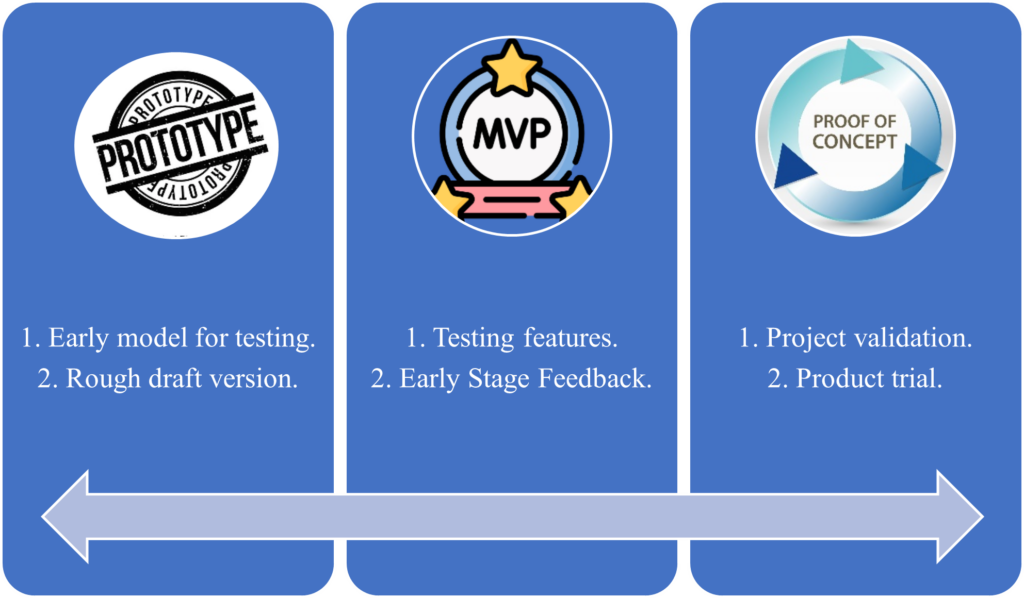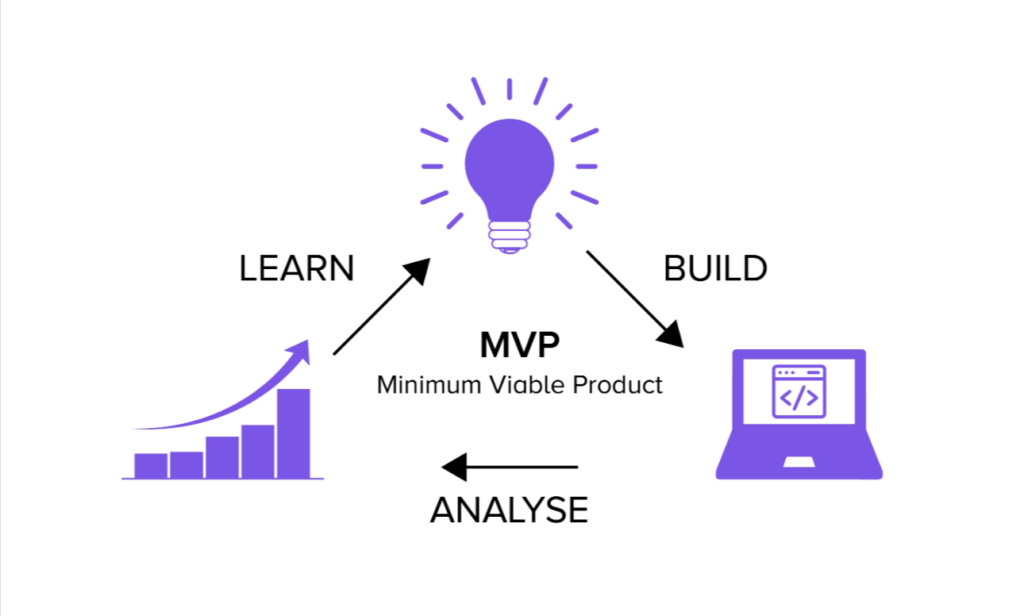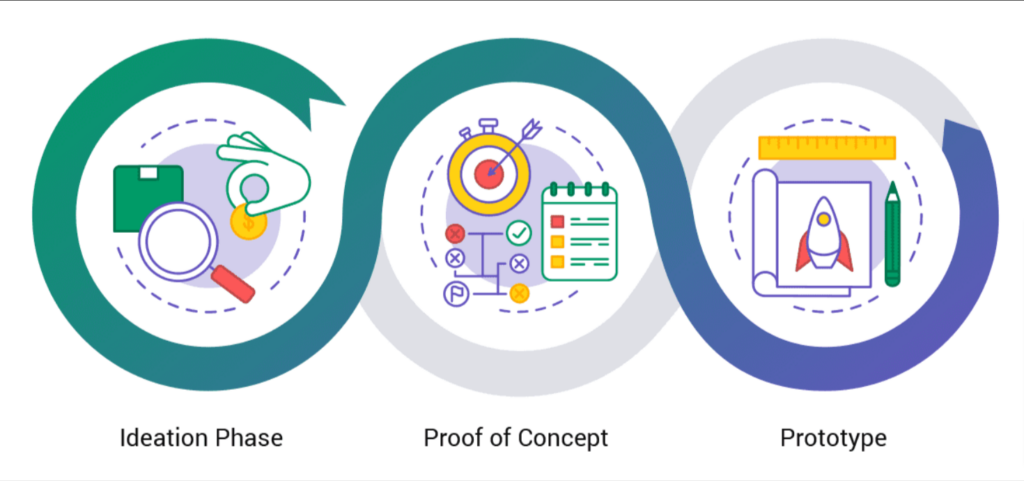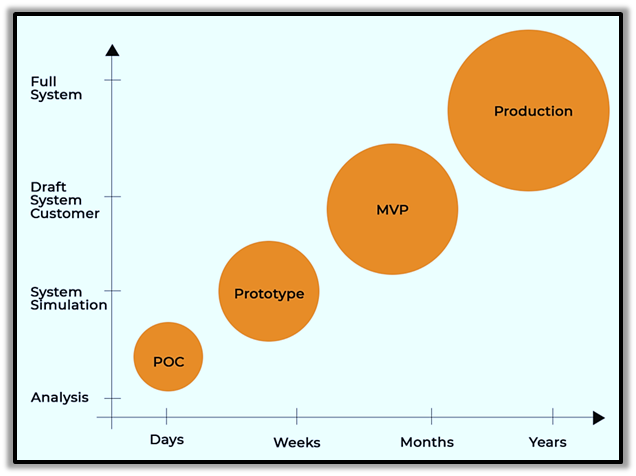PoC vs Prototype vs MVP: What to Choose?
MVP services support businesses to increase the probability of success because it helps in finding the right market fit and thorough testing during development. Idea validation is an essential first step that can save you trouble later.
Apart from this, there are three key approaches—PoC vs prototype vs MVP—each offers unique benefits and services in specific situations. Understanding their functions and differences helps you choose the ideal approach for your project.
As businesses and startups looking to bring innovative ideas to life, it is essential to understand the differences between a prototype, a minimum viable product (MVP), and a proof of concept (PoC). While these terms are sometimes used interchangeably, they each serve unique purposes in the product development process.

In this blog post, we will explore the key differences between these three concepts and provide guidance on when to use each in your own projects.
Prototype: The Tangible Idea
A prototype is a working model of a product or a feature, designed to test its functionality, usability and design. It serves as a representation of the final product, albeit with limited features and a potentially less polished design.
Purpose:
The primary purpose of a prototype is to validate product ideas, gather user feedback and iterate on the design. Prototypes can help identify potential issues early in the development process, saving time and resources.
Prototypes are primarily used to gather early feedback from real users and stakeholders before initiating large-scale development. They also help with:
- Identifying and addressing product flow gaps.
- Determining customer needs.
- Securing funding by demonstrating product appearance or functionality.
- Obtaining customer feedback without actual development.
A user-tested and refined prototype can form a solid foundation for further product development. However, there is one more approach that should be considered before proceeding with full-scale development.
When to use:
Use a prototype when you want to:
- Test the feasibility of your idea.
- Validate design decisions with real users.
- Iterate on the product design before committing significant resources.
Example:
- A physical model of a new car design.
- A wireframe or mockup of a software application.
Minimum Viable Product (MVP): The Essential Features
An MVP is a product with just enough features to satisfy early customers and gather valuable feedback for further development. It is typically the first version of a product that is released to the market.
Purpose:
The main goal of an MVP is to test the market and gather data on user preferences, demand, and potential areas for improvement. It allows businesses to validate their assumptions, learn from user interactions and prioritize further development based on real-world feedback.
Developing new products carries inherent risks. CB Insights revealed that 35% of startups fail due to not meeting market needs. Partnering with an MVP development services allows you to test the waters, reducing the risk of failure while saving time and money.
Reasons to build an MVP:
- Launching a business with minimal resources.
- Securing venture capital or crowdsourced funding.
- Avoiding major product rejections.
- Establishing customer relationships.
- Producing superior final products.
An MVP is ideal for determining whether a product idea merits further development and identifying potential profitability roadblocks. Having explored all three idea validation approaches, we can now focus on their unique differentiating factors.
When to use:
Use an MVP when you want to:
- Test your product in the market with real customers.
- Gather feedback for future iterations.
- Minimize the risk of a full-scale product launch.
Example:
- A simplified version of a mobile app with core features only.
- A limited release of a new product with essential functionality.

So, to generate early-stage feedback you can utilize the MVP development process to validate your idea. To gain competitive advantages, you must present your idea in the market after conducting an extensive level of testing with real audiences. Fortunately, MVP offers you this opportunity to test your idea in the market.
Read more: MVP Software Development: A QuickStart Guide to Success
Proof of Concept (PoC): The Feasibility Test
A PoC is a small project or experiment designed to test the feasibility of a specific concept, technology, or methodology. It focuses on answering the question, “Can it be done?”
Purpose:
The primary purpose of a PoC is to demonstrate that a particular idea or approach is technically and practically viable before committing to a full-scale project. It can help identify potential challenges and confirm that the proposed solution is a valid one.
Creating a PoC helps to:
- Solidify your product vision.
- Validate development strategies.
- Assess technical feasibility.
- Identify constraints.
- Estimate required resources.
- Minimize failures in later stages.
While PoC results are generally not shown to investors, they can demonstrate that your idea is technically and financially viable in projects with complex technical implementations.
Moreover, at Amplework we prepare the prototyping of various mobile application development as well as enterprise-level applications. Our prowess developers are well-versed in developing new applications & websites from scratch level.
When to use:
Use a PoC when you want to:
- Validate the technical feasibility of a new idea or technology.
- Test a specific hypothesis or assumption.
- Minimize risk and gain stakeholder buy-in before launching a larger project.
Example:
- A small-scale experiment to test a new machine learning algorithm.
- A pilot project to explore the viability of a new business process.

Read More: 9 Key Steps for Effective MVP Development: A Guide to Success
Comparison between prototypes, MVPs and PoCs across various dimensions
PoC vs prototype vs MVP, here’s a table comparing prototypes, MVPs, and PoCs across various aspects. You can use this as a reference when deciding which approach to use for your projects.
| Aspect | Prototype | Minimum Viable Product (MVP) | Proof of Concept (PoC) |
| Functionality | Limited, core features | Basic, essential features | Focused on a specific idea |
| Purpose | Validate & iterate | Market testing & feedback | Technical feasibility |
| Complexity | Varies, often simple | Simple to moderately complex | Simple, focused |
| Usage | Internal testing | External, early customers | Internal or external |
| Timeline | Short to medium | Medium to long | Short |
| Visibility | Internal stakeholders | Public, target audience | Stakeholders, decision-makers |
| Examples | Wireframes, mockups | The simplified app, limited release | Tech demo, pilot project |
| Cost | Low to medium | Medium to high | Low to medium |
| Risks | Low | Medium | Low |
| Outcome | Design improvements | Customer feedback, revenue | Validation, buy-in |

Understanding the differences between a prototype, MVP, and PoC is vital for making informed decisions during product development. Each concept serves a distinct purpose: a PoC focuses on technical feasibility, a prototype on design and functionality validation, and an MVP on market testing and customer feedback. By carefully considering which approach best suits your project, you can minimize risks and maximize success.
Read more: The Essential Guide to MVP Development: 20 Must-Ask Questions
Although, you need to focus on continuous product development to effectively enhance the productivity of your products or services. With continuous product development, we include advanced functionalities as well as key features that can be used to support you in targeting your audiences.
Conclusion
In conclusion, validating your product idea through the appropriate method is crucial for ensuring a successful outcome. Adopting the right strategy for your project’s needs will help you navigate the various stages of development, ultimately leading to a robust and well-received product.
At Amplework, we incorporate the latest technologies, smart IT labs, profound data security and many more operations to create advanced tech solutions for our clients. Our team of experts will work closely with you to understand your vision and transform it into a robust product.


 sales@amplework.com
sales@amplework.com
 (+91) 9636-962-228
(+91) 9636-962-228





